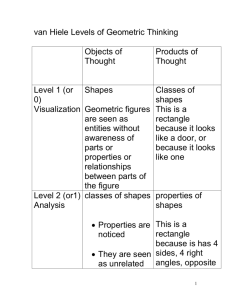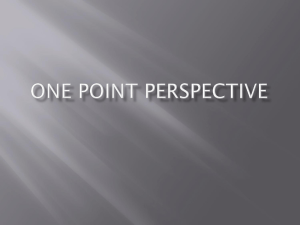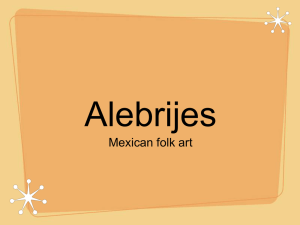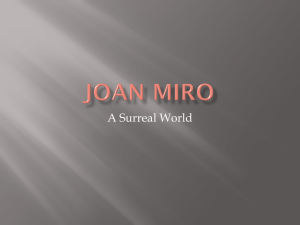Elements of art_The illusion of Depth copy
advertisement
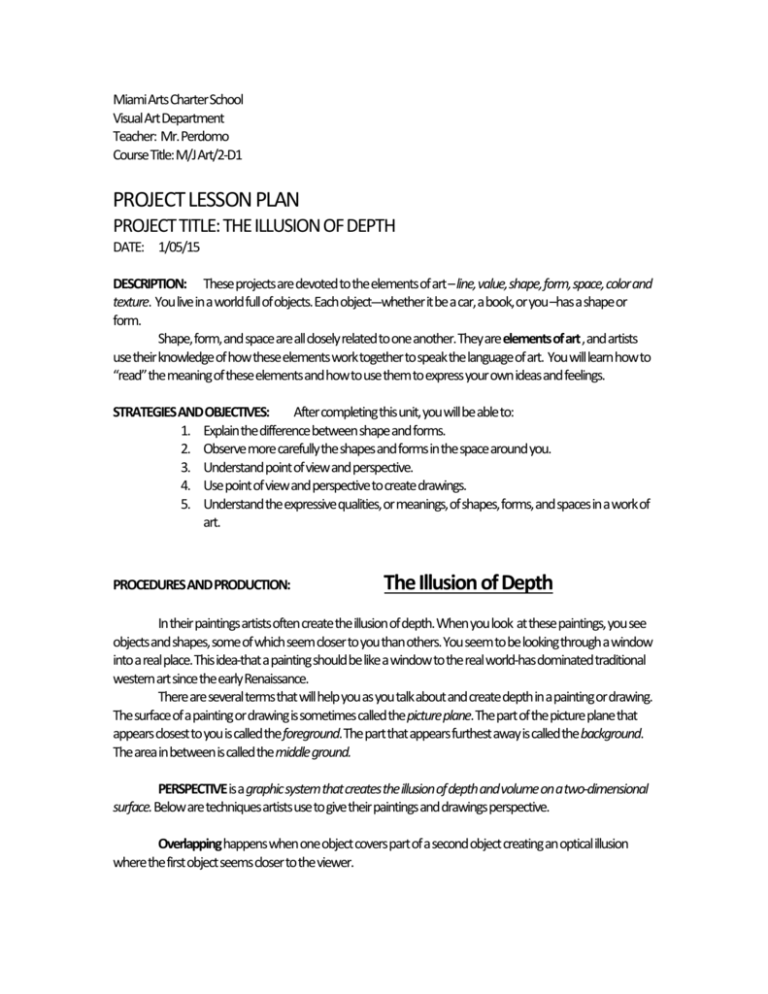
Miami Arts Charter School Visual Art Department Teacher: Mr. Perdomo Course Title: M/J Art/2-D1 PROJECT LESSON PLAN PROJECT TITLE: THE ILLUSION OF DEPTH DATE: 1/05/15 DESCRIPTION: These projects are devoted to the elements of art – line, value, shape, form, space, color and texture. You live in a world full of objects. Each object---whether it be a car, a book, or you –has a shape or form. Shape, form, and space are all closely related to one another. They are elements of art , and artists use their knowledge of how these elements work together to speak the language of art. You will learn how to “read” the meaning of these elements and how to use them to express your own ideas and feelings. STRATEGIES AND OBJECTIVES: After completing this unit, you will be able to: 1. Explain the difference between shape and forms. 2. Observe more carefully the shapes and forms in the space around you. 3. Understand point of view and perspective. 4. Use point of view and perspective to create drawings. 5. Understand the expressive qualities, or meanings, of shapes, forms, and spaces in a work of art. PROCEDURES AND PRODUCTION: The Illusion of Depth In their paintings artists often create the illusion of depth. When you look at these paintings, you see objects and shapes, some of which seem closer to you than others. You seem to be looking through a window into a real place. This idea-that a painting should be like a window to the real world-has dominated traditional western art since the early Renaissance. There are several terms that will help you as you talk about and create depth in a painting or drawing. The surface of a painting or drawing is sometimes called the picture plane. The part of the picture plane that appears closest to you is called the foreground. The part that appears furthest away is called the background. The area in between is called the middle ground. PERSPECTIVE is a graphic system that creates the illusion of depth and volume on a two-dimensional surface. Below are techniques artists use to give their paintings and drawings perspective. Overlapping happens when one object covers part of a second object creating an optical illusion where the first object seems closer to the viewer. Size. Large objects appear to be closer to the viewer than small objects. The farther an object is from you, the smaller it appears. For example, cars far down the road seem to be much smaller than the ones close to you. Or, if you were to stand at the end of a hallway and raise your hand, you can block a whole crowd of people from your view. You know that each individual in the crowd is approximately your size, but at a distance the crowd can appear smaller than your hand. Placement. Objects placed low on the picture plane seem to be closer to the viewer than objects placed near eye level. The most distant objects seem to be exactly at eye level. Eye level Detail. Objects with clear, sharp edges and visible details seem to be close to you. Objects that lack detail and have hazy outlines seem to be farther away. Look at your hand from at distance of 18-20 inches and you will be clearly see tiny lines and creases on your skin and also see the skin folding around your fingers. Now look at someone else’s hand from across the room. All the details seem to melt together because the distance between you and the second hand has increased. Color. Brightly colored objects seem closer to you, and objects with dull, light colors seem to be farther away. This is called atmospheric perspective. The air you breathe is not transparent. It is full of moisture that creates haze. Therefore, the more air there is between you and an object, the more the object seems to fade. Have you ever noticed how much brighter trees in front of you are compared to trees further down the road? Converging Lines. Linear perspective is one way of using lines to show distance and depth. As parallel lines move away from you, they seem to move closer towards the horizon line. When you look at the railway line, the tracks appear to move closer together. The case seems to be the same with the tops and bottoms of the telegraph poles and the road to the right of these. Not to worry, this is only an illusion. Understand that the sides of the railway tracks are just as far apart as they are in your present position. The telegraph poles are also the same height close to the horizon. They appear to meet at a point on the horizon line called the vanishing point. In one-point linear perspective, all receding lines or converging lines, as they are also known, meet at a single vanishing point. In two-point linear perspective, different sets of parallel lines meet at different vanishing points. Because twopoint perspective creates more diagonal lines in a painting or drawing, it seems more active. Renaissance artists used strict mathematical formulas to calculate perspective. Most modern and contemporary artists rely on visual perception over mathematical formulas. STUDIO ACTIVITIES: Studio Activity 1: Create three different designs on three separate sheets of paper. Each design should contain five shapes. Use the same five shapes in each design as follows: o Draw all of the items as close to the foreground as possible. o Draw one item close to the foreground and make the others look as if they are slightly farther back. (Hint, hint… Use overlapping and size). o Draw one item close to the foreground, one far in the background and the other in the middle ground. (Hint, hint… Use overlapping, size and placement). Studio Activity 2: Do the same exercise using three-dimensional forms instead of shapes. KEY WORDS TO KNOW: Form: Objects having three dimensions, height, width and depth. Forms are either geometric or free-form Free-form shapes: Irregular and uneven shapes. Their outlines can be curved, angular or both. Free-form shapes are often natural too. Geometric shapes: Precise shapes that can be described using mathematical formulas. Examples of basic geometric shapes are the circle, square, rectangle and triangle. Perspective: A graphic system that creates the illusion of depth and volume on a two dimensional surface. Perspective is created by overlapping, size variation, placement, detail, color and converging lines. Shape: A two-dimensional area defined in some way. Unlike a form, a shape has a height, a width but no depth. Space: The element of art that refers to the emptiness or area between, above, below or within objects. (BABW). Shapes and forms are defined by space around and within them. Picture Plane: The surface of a painting or drawing. Overlapping: When one object covers part of a second object creating an optical illusion where the first object seems closer to the viewer. Placement: Objects placed low on the picture plane seem to be closer to the viewer than objects placed near eye level. The most distant objects seem to be exactly at eye level. Convergence or Converging Lines: Technique for creating a focal point by arranging elements so that many lines or shapes point to one item or area. One-point linear perspective: All receding lines or converging lines, as they are also known, meet at a single vanishing point. Two-point linear perspective: Different sets of parallel lines meet at different vanishing points. Vanishing point: Point on the horizon where receding parallel lines seem to meet.




